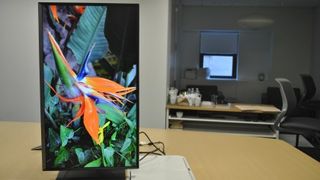Why you can trust TechRadar
As I mentioned, one of the selling points of the UD970 is PBP support for up to four input sources at once. One of those input sources might very well be for a PC game and, not being a gamer myself, I asked Wes Fenlon, the Hardware Editor for our sister site PC Gamer to deliver a more professional opinion about the display's gaming suitability. Wes put down the broadsword he was carrying around the office long enough to explain that the most important requirement for gaming is response time. For monitors, he said, there are two components. One is the pixel response time or how fast the pixel can go from on to off and change colors. Slower than 10 milliseconds response time and you'll start to see some kind of ghosting when things on your screen are moving really quickly. "There's also input lag," Wes said, "which is basically how long it takes a command to appear on the screen when you move your mouse."

By Fenlon's exacting standards, the UD970 8ms response time was a little slow to be used as a gaming screen by hardcore gamers who are used to a little faster "slicing and dicing." To demonstrate, he downloaded and ran a minute-long version of the game Bioshock Infinite by Irrational Games that he uses to benchmark game hardware and noted several times where the video frame rate appeared to "stutter." To my untrained eye, the game movements appeared quite fluid. I was more than a little blow away by the colorful floating world's fair imagery (circa 1912) in Bioshock Infinite, so I may not have been paying close attention to video frame rates and other such prosaic details.
Like me, Fenlon was impressed by the fact that the monitor could be rotated into portrait mode. Using the UD970 in portrait mode takes a while to get used to, but you'll likely find that portrait is superior to landscape mode for any number of web tasks. For one thing, browsing the web in portrait mode allows you to see more of a website at one time, since almost all websites are designed for up-and-down rather than left-to-right scrolling. Portrait mode also makes it easier to read and respond to lengthy email chains. You'll be surprised at the day-to-day usefulness on dividing up the display into over and under Picture By Picture windows, so that you can view photos, blueprints or videos of people, places and things in one window while typing a response in another. The clarity and color accuracy of the monitor means you're not going to miss many details, whatever orientation the UD970 is in.

The big thing with 4K displays is that there is so much data: 8.1 million pixels that you're refreshing 30 times or 60 times a second. This is too much for most computers on the market right now to handle, which I experienced firsthand when I connected my MacBook Pro laptop in an attempt to mirror my Mac screen in another PBP window. The result, even when I identified the input source as DVI rather than HDMI, was a distorted image worthy of a fun house mirror.
Button, button, who's got the button?
I selected the number of PBP windows on the UD970 display by mashing hardware buttons on the lower right-hand side, underneath icons etched on the bezel. In addition to input selection, these buttons control things like sound and brightness. I eventually figured out how to setup, size and resize the PBP windows, but I found the menu navigation using multiple buttons far from intuitive.

